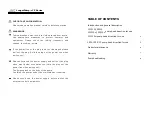
Oil Lubrication
Use oils selected from the following table according to
the application and ambient temperature existing at the
freewheel.
Note:
FRS and FRZ-300 thru 1000 freewheels are
shipped from Ringspann half full of Dexron III Automatic
Transmission Fluid.
For applications where the ambient temperature
e150°F (+65°C) consult Ringspann.
Do not use lubricants of the EP type
(extreme pressure characteristics) or those
containing slippery additives such as sulfur
phosphate, graphite, or molybdenum disulphide
.
Temp. Range Recommended Oil Lubricant
0°F to 150°F
MOBIL Multi-Purpose ATF (Dexron III)
TEXACO Havoline ATF (Dexron III)
CHEVRON ATF (Dexron III)
-20°F to 60°F
MOBIL DTE-15M
TEXACO Rando-HDZ 46
CHEVRON Hydraulic Oil AW MV 46
-50°F to 32°F
MOBIL Aero HF
TEXACO Aircraft Hydraulic Oil 5606G
CHEVRON Aviation Hydraulic Oil A
Important:
Do not mix oils. When switching from one
brand or type to another, drain old oil and flush
freewheel with mineral spirits, such as MOBIL
SOLVASOL or equivalent. Do not use any solvent
containing Carbon Tetrachloride.
The use of lubricants in freewheel
assemblies, other than shown, can compromise proper
function that may cause personal injury or property
damage and will automatically void any warranty.
Ringspann is not responsible for any lubrication changes
made after the freewheel leaves our factory.
Oil Lubrication Maintenance
1.
Inspect the oil level once a month or every 160
hours of operation, whichever occurs first. Indexing
applications that operate in excess of 150 strokes
per minute and severe duty applications may require
more frequent oil level inspection.
2.
Add oil if necessary to maintain the proper level.
Overrunning, Backstopping....... 1/2 full
Indexing.................................... 7/8 full
3.
To assure continued efficiency of operation, flush
freewheel every 6 months with mineral spirits.
Do not use any solvent containing Carbon
Tetrachloride as seal damage may occur.
Important:
Under severe operating conditions, such
as heavy dust or twenty-four hours per day
operation, flushing may be required at shorter
intervals.
Flushing will remove waxes and gums formed by
vaporization of the oil and helps assure continued
efficiency of operation. See “Flushing Procedure”.
4.
Flush with mineral spirits and relubricate before use
if freewheel has been out of service or in storage for
six months or more. Use recommended oils only.
In cases of dirty or abrasive environment or severe
operating conditions (24 hours per day), it is
recommended that oil be changed every month.
5.
If the freewheel is out of service or in storage for two
years or more, new seals should be installed before
freewheel is put into service.
Oil Lubrication – Filling Procedure
Overrunning and Backstopping Applications
1.
Rotate freewheel outer ring as shown in Figure A.
2.
Remove (A) and (B) plugs and add oil through (A)
until oil flows from (B). The freewheel is now 1/2 full.
3.
Reinstall (A) and (B) plugs with sealing washers and
tighten to prevent leakage.
Indexing Applications (up to 150 strokes per minute)
Note: Contact Ringspann for indexing applications in
excess of 150 strokes per minute
1.
Rotate freewheel outer ring as shown in Figure B.
2.
Remove (A) and (C) plugs and add oil through (A)
until oil flows from (C). The freewheel is now 7/8 full.
3.
Reinstall (A) and (C) plugs with sealing washers and
tighten to prevent leakage.
Flushing Procedure
1.
Rotate freewheel outer ring to locate plug (B) in the
6 o’clock position.
2.
Remove plug (B) and drain oil from freewheel.
Remove plug (C) for better drainage.
3.
Reinstall plug (B) and completely fill freewheel with
mineral spirits. Reinstall plug (C).






















